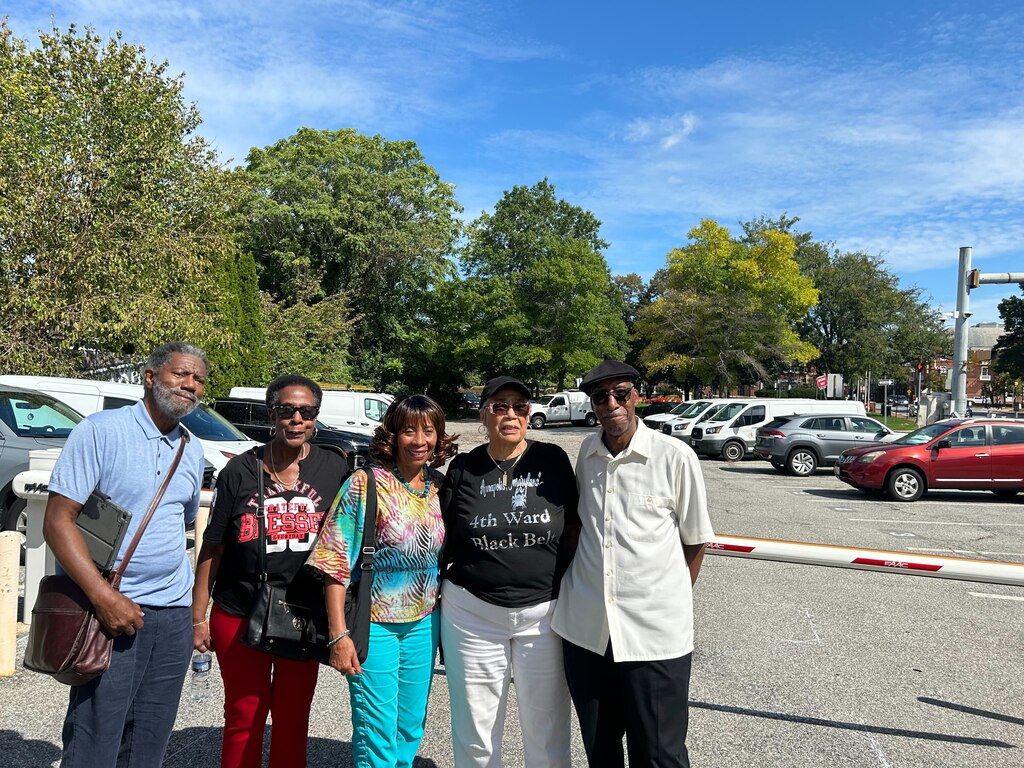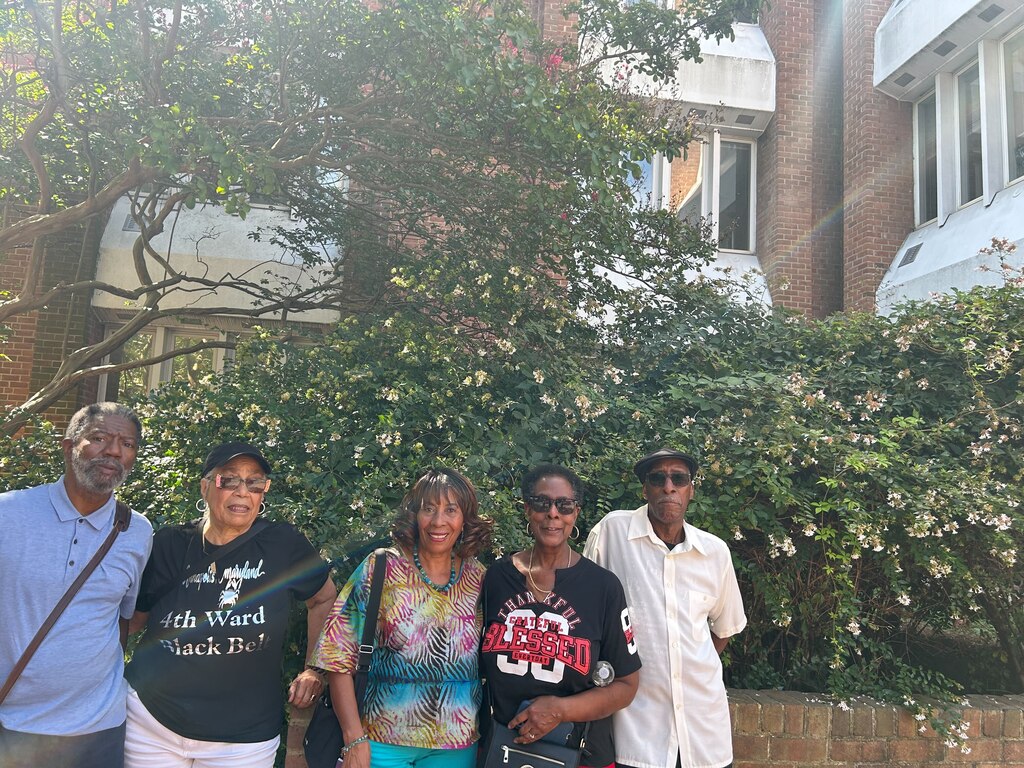Seventy-five-year-old Argo Duenas stood recently in front of a parking garage on Calvert Street in Annapolis, recounting with emotion how her childhood home once stood on that very spot.
“My great-grandmother in 1944, built that house on West Washington Street, a single woman with two little boys,” Duenas said. “She worked at the Naval Academy. That speaks volumes. She had very little education, but she intuitively knew the value of homeownership, a generational wealth to pass down to take care of her children, her family.”
Her family was among many Black people that were displaced for redevelopment efforts and relocated to the fringes of Annapolis to newly-built apartment buildings. Many homeowners with fully paid-off mortgages had to become renters again.
“Our economic base was destroyed. Our political willpower influence was wiped out,” Duenas said. “Generational wealth was wiped out for a lot of people, because then [homeowners] became renters.”
Walking past county buildings and parking garages near Calvert Street recently, members of the Coalition for Atonement and Repair, including Duenas, recalled the days when the “Harlem of Annapolis” had a Black church, Black beauty salons and barbershops, a Black-owned drug store and, most importantly, Black homeowners.
That was before urban renewal uprooted the community.
In the late 1960s and early 1970s, redevelopment efforts in Annapolis — for government buildings, a parking garage and parking lot — displaced many families and destroyed a historic Black community. Now, the coalition is seeking “apology with action” for the long-lasting effects.
Urban renewal is defined as a strategy for redeveloping and revitalizing substandard and blighted open areas for residential, commercial, industrial, business, governmental, recreational, educational, hospital or other uses.
Members of the coalition said urban renewal really means urban removal.
“It was destruction. It was decimation. It was psychological trauma, and we are still healing from that today,” Duenas said.
Walking through the area known as the Old 4th Ward, former Annapolis Alderwoman Cynthia Carter pointed out where her childhood home was before it was torn down.
Carter, 85, said her house was next to the historic Black St. Philip’s Episcopal Church, where she would go for services and recreation.
St. Philip’s was a church, but it was also a gathering spot for youths. There were dances and a basketball court. They said St. Philip’s was the only church that allowed social gatherings.
Peggy Randall, a member of the church, said when it was torn down, members had to figure where to worship. The elders of the church contacted St. Anne’s Episcopal Church, a white church down the road.
“They said, ‘Okay, we’ll let you all worship here.’ For about three years, we had to worship there. We were not welcome or wanted. It was blatant discrimination.”
Carter recalled how after church, women would take off their regal church hats and head down to the local clubs to enjoy live music and dancing.
During one part of the tour, members of the coalition gathered at a parking lot across from the Arundel Center, a county building that was once the only Black movie theater at the time, Star Theatre.

Crawford McPherson, who lived in a house across the street from the theater, said his cousin worked as a projectionist there. After the theater closed for the night, he and his cousin would watch movies together.
“We’d go back in and open it back up. We’d go in there and eat the hot dogs and pop the popcorn and look at the shows all over again by ourselves,” McPherson said.

The Old 4th Ward was once the home of freedmen displaced by the expansion of the Naval Academy and St. John’s College throughout the early 1900s. They resettled in the 4th Ward of downtown Annapolis, where they established a new community.
In the late 1960s and early 1970s, their descendants were again uprooted for urban renewal.
In 1963, the Annapolis Urban Renewal Agency was established to remove deteriorating structures and improve the community facilities, according to the coalition. Homes and businesses were purchased or taken through eminent domain, “the power of the government to take private property and convert it into public use.”
The garage was named after John Whitmore, the first chairman of the Anne Arundel County Council under charter government, and a white man, according to the Capital Gazette.
Displaced residents ended up at public housing communities along the edge of Annapolis where some remain to this day. They were now far from their jobs, grocery stores and other essential businesses.
The coalition said the impacts of “deplorable governmental actions persist in Annapolis” with substandard housing, unsafe communities and persistent inequities.
“Gross disparities remain evident in housing, education, employment, wealth, and health,” a statement from CAR said.
Over 237 families and 33 businesses were impacted by urban renewal in the 4th Ward, according to CAR.
“This separation from their community and support networks had devastating effects. Within a few years, many of these families began a downward spiral into extreme poverty. Their businesses had been shut down, and owners lost their livelihoods, further straining family stability and well-being,” the CAR statement said.
The coalition started with Duenas wanting to address the harms of urban renewal that she had experienced. She then gathered people who had similar experiences.
Ahsun Powell, CAR facilitator and strategist, pointed out that the organization is seeking atonement from the state, city and county, not reparations, which are reserved for federal action.
“Atonement is something that the state can do to basically address some of the grievances, but they cannot make us whole,” Powell said.
To the organization, atonement would involve a holistic approach to justice that encompasses emotional, social and economic aspects — to restore dignity, rebuild public trust and create opportunities for those who have been wronged and harmed by local governments.
“It’s not just cash payout, but it’s transformational policies to ensure that this never occurs again,” Powell said. “It’s addressing the health disparities of that group. It’s addressing the lost wealth of that group. So, our goal is to retain as much as we can back from what was lost from them.”
At a Sept. 9 Annapolis City Council meeting, members of the Old 4th Ward came together to ask for restorative justice and repair.
CAR is calling for the city “to provide an apology that takes responsibility for the harms of Urban Renewal, commit to tangible repair for said harms, and create a framework of accountability to those harmed.”
Annapolis Mayor Gavin Buckley said the city is discussing an apology.
“We’re already talking about an apology and how, as a Council, we frame that,” Buckley said in a statement. “Since before I was Mayor, I recognized the injustice of what was done — people moved across the tracks with one road in and one road out. Those actions have a lasting impact on communities. From here, we will need to work with the county and state to look at the properties and how we can go about making it right.”
County Executive Steuart Pittman echoed similar sentiments. He is working to rename Whitmore Park as the People’s Park.
“The County recognizes the lasting impact of urban renewal on the families, businesses, and descendants of Annapolis’ Old Fourth Ward community,” Pittman said in a statement. “We are committed to working alongside the City of Annapolis, the State of Maryland, and impacted residents to explore meaningful actions that can address the harm caused.”
This story has been updated to correct the name of St. James church to St. Anne’s Episcopal Church.





Comments
Welcome to The Banner's subscriber-only commenting community. Please review our community guidelines.